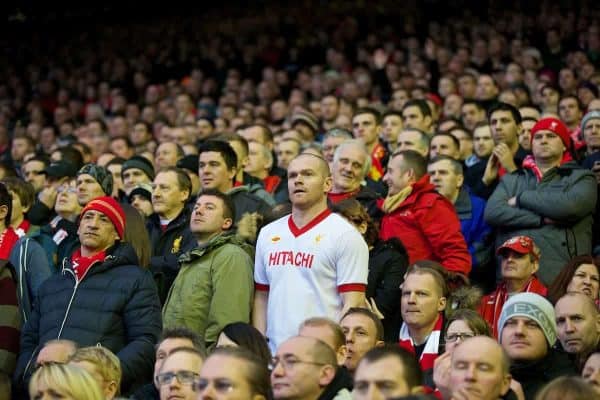With the Premier League’s announcement that safe standing has been discussed at its latest members meeting, the debate as to the possible introduction of standing areas in English football stadiums has again been brought front and centre.
There has been a growing desire to discuss the issue over the past couple of years, with groups such as the FSF (Football Supporters Federation) at the forefront. And, despite the current legal position outlawing standing at football matches in England, as well as reasonable opposition from certain quarters – not least the HFSG and many Liverpool supporters – the likelihood of a safe standing trail in some form looks increasingly plausible.
As a long time Anfield regular and season ticket holder, who this year relocated to Germany for work, I have been able to gain first-hand experience of how safe standing works, and how that contrasts with the common experience at football grounds in England.
The Bundesliga is often presented as the shining example of safe standing and the fan experience more widely. Though standing in top-flight football grounds is common place in other areas of Europe, including Scandinavia, Holland (and most recently Scotland), it’s Germany which receives the greatest level of attention.
There are two broad benefits most commonly attributed to safe standing: cheaper ticket prices and greatly improved atmosphere.
Dealing first with the cost. From my experience, it’s certainly true that football can be more accessible and affordable over here than it is in England. The presence of standing areas in stadiums is one of the main factors which allow Bundesliga clubs to charge sub €20 for an allocation of tickets for every league match.

I recently paid as little as €12 for a 2.Bundesliga (second tier) game, and there are tickets available for every top flight game for a little as €17 – certainly a welcome relief from the often eye watering entrance prices to English football grounds.
Having said that, standing is almost certainly not the only reason for the more affordable prices, and to say that all tickets in Germany are universally cheap would be someway wide of the mark.
Most Bundesliga clubs seem to favour the tiered approach to ticket pricing – which is also becoming more common place in England. So, whilst some tickets are sold for €15-20, other top-end (non-corporate) seated tickets retail for three or four times that price.
When I recently decided to go to Hamburg SV v Borussia Dortmund, and after the cheap tickets were snapped up before going on general sale, I wasn’t able to buy an advanced ticket for less than €70 (before eventually paying €60 to one of the many touts outside the ground).
If you’re not lucky enough to pick up one of the affordable tickets (most of which, to be fair, are being bought by the regular hardcore fan), you have to be prepared to cough up the cash – at least for the bigger games. Perhaps that’s just one of the ill-effects of being a “football tourist”.

The standing tickets are also invariably those in highest demand. Of course, partly due to the fact they are the cheapest tickets available, but also because they tend to be the best part of the ground from which to watch the game from an atmosphere viewpoint.
On that note, it would be interesting to see whether Premier League clubs – famous for chasing the next buck – would be quite so noble in holding standing ticket prices at, perhaps, artificially low levels compared to demand, were safe standing to be trialled in England.
To be fair, though, the recent introduction of a £30 cap on all away ticket prices shows that clubs in England are becoming more receptive to a way of thinking which isn’t entirely blinded by profit margins and balance sheets.
Then we come to the atmosphere question itself. A big issue in the Premier League.
There is no doubt that providing the opportunity for fans to stand together (and in the case of Germany, have a beer), often in an unallocated and safe section of the ground, encourages a better atmosphere. The availability of cheaper tickets also makes football in Germany more inclusive and accessible to all, regardless of age, economic status etc. Another factor which no doubt adds to a more raucous atmosphere in the ground.

Most Bundesliga stadia are actually predominantly seated with one or two exclusive standing areas. What that achieves is a focal point for atmosphere – something we already have at Anfield to a large extent in the form of the Kop, but which other more modern grounds in England often lack.
Personally, I would still take Anfield at its best ahead of what the Bundesliga has to offer, but the German model does give a guarantee of “atmosphere” at more or less any given Bundesliga match, no matter how run of the mill.
That is also partly attributable to the “ultra” fan culture well established throughout Germany. The fan groups organise most of the vocal and visual displays of support for the team, and also give a sense of shared cause which often transcends what is happening on the pitch.
It’s doubtful the megaphones or some of the other more orchestrated elements of the support would find a home at Anfield. But, there is no doubt, at least from an accessibility and atmosphere perspective, that safe standing could transform how we watch football in England in a similar way to other countries around Europe.

















Fan Comments